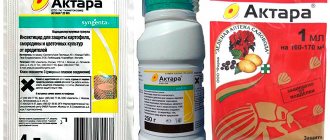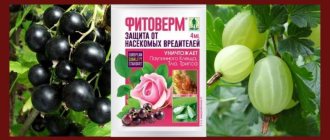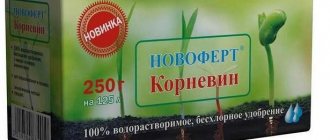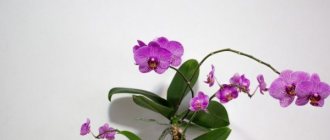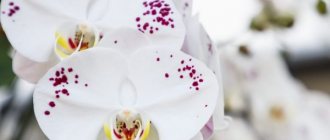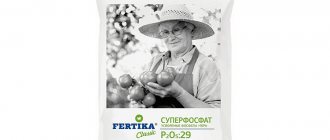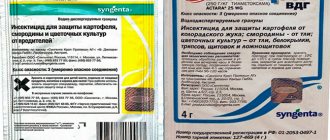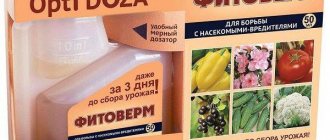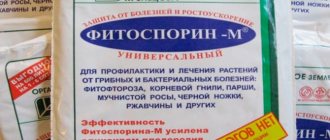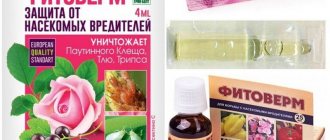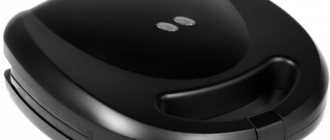Systemic insecticide, also has an intestinal contact effect. Active ingredient: thiamethoxam, at a concentration of 250 g/kg and 240 g/l. Manufacturer: Syngenta Crop Protection AG, Switzerland. Available in the form of water-dispersible 1% granules, 25-35% suspension concentrate. Analogs and synonyms: Aktara, VDG; Aktara, KS; Doctor, TB; Adamant, gel; Cruiser, KS; Tiara, KS; Ephoria, KS, etc.
Used to protect garden crops and indoor plants from a wide range of pests (thrips, scale insects, scale insects, Colorado potato beetles, aphids, etc.), not effective against mites, ineffective against whiteflies!
Scope of application and release form of "Aktary"
The drug "Aktara" is produced in Switzerland. This insecticide began to be produced taking into account the wishes of customers. It can be used for the following purposes: to protect vegetables ; orchids, violets and roses in the garden; indoor plants.
Application is possible to get rid of a number of insects , all of which are not listed in the instructions. Thus, the instructions for Aktara (insecticide) do not mention that it copes with spider mites. But this does not mean that the drug is not able to get rid of it.
For ease of use, the drug "Aktara" has different release forms:
- liquid in the form of a suspension concentrate;
- granules soluble in water.
The drug in solid form is packaged in 4-gram sachets. According to the norm, this will be quite enough for spraying tomatoes in a greenhouse and other plants. But for use in large farms and agricultural enterprises, Aktara is used in large bags of 250 grams.
The suspension is in ampoules and vials . Small packaging helps to process the following types of plants:
- Small strawberry beds.
- Violet flower beds.
- Indoor flowers.
- Rose bushes.
- Orchids.
Aktara helps protect these and other plants from scale insects and spider mites.
Active ingredient and analogues
The insecticide contains thiamethoxam - this is its active ingredient, which makes up a quarter of the weight of the drug. “Aktara” is absorbed into the leaves of the plant through the skin or soil when watering. Then it spreads through the vessels.
When the drug permeates plant tissue, it is no longer afraid of rain or heat, because the insecticide works regardless of weather conditions.
Analogs of "Aktara" are:
Aktara indoors
For greenhouse and indoor plants, it is better to buy liquid Aktara: it is convenient to take it out of the package with a syringe (see above) literally milligrams at a time (if you use an insulin syringe. The norms and schemes for using Aktara in greenhouses are the same as for open ground. But it is better to spray indoor flowers just use a hand-held sprayer in places where pests are concentrated (see figure).
Indoor plants affected by sucking pests
They give approx. 1/4 of the dose, evenly distributing this share among the nests, and the rest is used in the usual manner. For example, how to use Aktara for violets and cyclamens, see the video:
Video: Aktara processing of new violets and Cyclamens
It is better to take Aktara for flower greenhouses in ampoules of 1.2 g each. The ampoule is diluted in 6 liters of water for sporadic and moderate damage to plants or in 3 liters of water for severe damage. A portion of the working solution will be enough for approx. for 100-150 small plants and 200-300 large ones. For preventive watering, the same Aktara ampoule is diluted in a bucket of water. Watering rate is 50 ml per 1 liter of pot volume or 70 ml per 1 cubic meter. dm container for soil. For indoor plants, 10 liters of watering solution is plenty. To make it smaller, you need to take not an ampoule, but a 1.4 g package of VDG and divide it into parts, as described above. However, here every gardener has his own tricks, see for example. plot:
Video: how to breed Aktar for indoor plants
However, the danger of Aktara indoors does not decrease at all. Therefore, both spraying and watering with Aktara are carried out next. way:
- Before starting work with Aktara, everyone except the operator leaves the room in which the processing will be carried out;
- Doors and windows close tightly;
- Having finished work (PPE is a must!), the operator also leaves the room, tightly closing the door behind him;
- The room is kept closed for 2 hours;
- After the exposure period has expired, the room is ventilated for 6 hours after spraying and 2 hours after watering;
- Free entry to the premises opens no earlier than 24 hours after treatment with Aktara. Until then, only the operator in PPE can enter, tightly closing the door behind him.
If Aktara is used for indoor flowers in an apartment, treatment with the drug can only be carried out in a glazed balcony or loggia. The door to living rooms must have a seal. If it is not there, you need to arrange a temporary one by gluing with tape along the contour of the doorway a linen cord in 2-3 rows.
Compatibility
Aktara is compatible with all agrochemicals that have a neutral or slightly acidic reaction, incl. containing other neonicotinoids. Incompatible with alkaline compounds: Bordeaux mixture, any preparations with lime, soap or based on an infusion of stove ash.
What pests does the drug protect against?
Insecticide "Aktara" helps save garden and vegetable plants from the following pests:
- Colorado beetle;
- Chafer;
- spider mite;
- whitefly;
- scale insect;
- Khrushchev larvae;
- aphid;
- thrips and others.
Splashes of the product when spraying plants fall on caterpillars and beetles, then penetrate their body and the poison begins to take effect. The insects eat the poisoned plants, ingesting an insecticide that destroys their nervous systems. After half an hour, the parasites cannot eat anything and soon die. If the insecticide is applied to the soil, underground pests are killed.
The drug "Aktara" costs 75-100 rubles for a package of 4 grams, and 3500-5 thousand rubles for 250 g, respectively. The product should be stored in utility rooms, on high shelves or closed cabinets. Children and animals should not get there.
It is not recommended to store food, medicine or feed near the drug. The room temperature should be between 10 degrees below zero and 35 degrees above zero. Do not store Aktara in places of high humidity.
Expiration date and storage location
The shelf life of Aktara is 4 years from the date of manufacture. The drug should be stored separately from food, medicines and animal feed. You cannot use the drug after the expiration date - its effectiveness drops sharply.
Aktara: reviews from those who used the product
Elena, 45 years old, Volgograd region: In my garden, I try to use chemicals as little as possible so as not to harm my cultivated plants.
But in recent years, my berry bushes have been overcome by aphids; folk remedies did not cure them. Therefore, I had to use Aktara. I used the drug twice during the season - before the bushes began to flower and after harvesting. As a result, the aphids disappeared from my area. Olga, 50 years old, Ulyanovsk region: I have a very large garden, where my husband and I grow potatoes for our own needs and for sale. To prevent potatoes from being damaged by wireworms and the Colorado potato beetle, it is necessary to carry out treatments with Aktara. As a result, these insects are not on my potatoes. But the last treatment with this drug can be carried out about a month before harvest.
Tatyana, 35 years old, Moscow region: I really love indoor plants, I have been breeding them for many years. Pests rarely appear on them; I usually deal with them using Aktara solution. It is enough to carry out one or two treatments during the summer period for the pests to disappear. But spraying must be carried out with the window open.
Aktara is a good contact-intestinal insecticide that is used to control most pests
. But when carrying out treatments, precautions should be taken.
"Aktara": instructions for use
You need to start working only when you first see ticks, beetles or caterpillars. Treatment should be carried out in calm, clear weather in the morning or evening, and only when you are sure that there will be no rain. An hour must pass after application for the insecticide to adhere to the leaves.
The prepared solution cannot be stored , so the composition should be prepared only in the quantity that you will need immediately. It is best to use a backpack sprayer, which is prepared directly in the can.
The preparation of Aktara looks like this:
- Dissolve four grams in a liter of water at a temperature of 25 degrees in the open air.
- Fill the sprayer tank a quarter full.
- Pour in the concentrate in the required volume for a particular plant.
- Fill the container with up to 5 liters of water.
- Close it tightly.
- Shake the sprayer.
Application for flowers and other plants
To protect your violets, cyclamen and other indoor plants from insects, you need to dilute 4 grams of the drug in 5 liters of liquid . This will be enough for a large greenhouse. For treating vegetable gardens, the consumption of the drug per 10 liters of liquid may vary slightly depending on the type of plant:
- Currants – 2 grams.
- Tomatoes - 4 g. by watering at the root.
- Cabbage seedlings against fleas - 3 g (at the root).
- Cucumbers - 3 grams when sprayed and 8 grams when applied to the soil.
- Onion – 4 g when sprayed.
- Eggplants – spraying – 3 grams and at the root 8 g.
- Roses, violets or orchids - 4 g for aphids and 16 for thrips.
- Fruit trees (plums, pears or apples) – 4 g.
- Grapes – 3 g.
Shrubs and fruit trees need to be treated for the first time before flowering and the beetle emerges , and for the second time after harvesting the fruits. Instructions for use contain information about the use of the drug depending on the pest and plant type.
If you use the drug in liquid form for different plants, you need to dilute one ampoule in the following amount of liquid:
- strawberries or currants – 6 liters
- orchids, roses and violets - 0.75 liters;
- onion – 3 liters.
Related article: Mospilan: instructions for use, reviews, storage of the drug
To prevent Aktara resistance from appearing in the cockchafer, whitefly or spider mite, its use must be alternated with other insecticides .
Planting processing
A preparation such as Aktara can also be used to treat planting material . A highly concentrated solution is required, the consumption is 4 grams per liter of water. To process potato tubers, 6 g of powder is dissolved in 0.3 liters of water.
And seeds, potato tubers, onion heads and garlic cloves need to be soaked in the composition . Do not be afraid of high concentrations of the product; it completely decomposes in 60 days.
After processing edible plants of any kind, they are safe for humans after a couple of months. Soaking in the composition plants take root and develop better If they get stronger, I will be less susceptible to harmful insects.
Action diagram
It has an intestinal contact effect, systemic and translaminar activity. That is, it effectively acts on pests both from the outside - when it comes into contact with the surface of the body, and internally - when the parasite consumes parts and juices of the treated plant.
Symptoms of the drug appear within 10 minutes. After the first 30 minutes, due to intestinal upset, the insects stop feeding, and death is observed within 24 hours.
There is no possibility of resistance developing if these recommendations are followed, but with active use it is better to alternate with other substances (Pegasus or Actellik). However, in a small greenhouse or apartment this is not necessary.
Due to the rapid absorption of the drug by the plant, within 20 hours it is distributed throughout the entire body of the plant, partially accumulating.
The metabolism of the substance is slow, which determines its long-term protective effect, which is approximately 3-4 weeks; when applied in soil, this period increases to 7 weeks.
In addition, this method will make it possible to use predatory insects for your own purposes, which may live on your plants. Below you will learn how to treat an orchid with this drug.
Safety rules for use
"Aktara" is a moderately dangerous drug for humans with toxicity class 3. It is used with gloves, a respirator and goggles . And also when working with chemicals, you need to wear a special uniform and wash it after each use.
At the end of the work, protective equipment and tools should be washed, and you should also wash your face, hands , swim, change clothes, and rinse your mouth. Only after all this should you eat or drink. Indoor plants are processed in the fresh air or in a well-ventilated room. Upon departure the symptoms are:
- Vomit.
- Nausea.
- General deterioration in health.
If you notice something like this in yourself, stop processing and go outside. If the insecticide gets on your skin, blot the drops with a cloth and wash it off with soapy water . If it gets into your eyes, wash them for 15 minutes under running water. And if swallowed, the stomach is washed and several tablets of activated carbon are taken.
After first aid has been provided to a person, he needs to call a doctor . To prevent anyone from swallowing the product, it should not be stored in food containers, and the containers should be labeled.
Do not pour the remaining solution near water bodies. And also do not process honey plants earlier than a week before flowering, so as not to kill the bees. Pastures should not be watered before grazing . After use, the tapa is burned in a place where no edible plants are planted.
"Aktara": reviews
Now let’s find out what those who have tried this product to protect their plants write in their reviews.
“Aktar” was recommended to me by experienced flower owners who have used it for their plants more than once. You need to spray them from all sides, and even the tray where the flowers stand. Remember that the drug is toxic, but the smell is not very strong. This makes it possible to use even at home.
It should be used once every six months. And if there is mealybug, then the plant needs to be treated 4 times within 4 days. Particular care must be taken to treat the center of the flower, where most of the larvae are concentrated.
I used Komandor and Molniya without success against Colorado beetles, after which I decided to try Aktara in granular form. Used to protect potatoes, flowers, and currants. The granules are highly soluble in water and should be used in the amount required depending on the type of plant.
I liked the drug, but the main drawback is that for one garden you need a lot of ampoules. I had previously used a lot of things for the Colorado potato beetle, but nothing helped. But I liked Aktara in liquid form. I poisoned the beetles in the morning, and in the evening they all died and did not appear for a month. Another big plus is the absence of an allergic reaction for sensitive skin.
As you can see, the drug "Aktara" helps protect indoor plants, as well as garden crops, from a number of pests. This even applies to spider mites, which are traditionally considered a fierce enemy of violets, orchids and roses and are not listed in the instructions for the product.
With this drug you can water the plants at the roots or spray them. Applying it at the root helps strengthen the planting and develop the root system of strawberries and vegetables. And this is not the only advantage of Aktara, which has a huge number of advantages compared to other drugs.
Aktara - systemic insecticide
Systemic insecticide, also has an intestinal contact effect. Active ingredient: thiamethoxam, at a concentration of 250 g/kg and 240 g/l. Manufacturer: Syngenta Crop Protection AG, Switzerland. Available in the form of water-dispersible 1% granules, 25-35% suspension concentrate. Analogs and synonyms: Aktara, VDG; Aktara, KS; Doctor, TB; Adamant, gel; Cruiser, KS; Tiara, KS; Ephoria, KS, etc.
Used to protect garden crops and indoor plants from a wide range of pests (thrips, scale insects, scale insects, Colorado potato beetles, aphids, etc.), not effective against mites, ineffective against whiteflies!
Instructions for use
Aktara belongs to the chemical class of neonicotinoids, acting on the nicotinic acetylcholine receptors of the insect nervous system. The active substance, thiamethoxam, penetrates mainly into the leaves through the vascular system, but practically does not enter the fruits. At the same time, the drug is completely redistributed throughout the leaf tissues of the plant 20 hours after watering. When watering large plants with actara, after 1 - 3 days the solution reaches the upper stems and shoots. Aktara is resistant to sunlight and does not reduce its effectiveness in dry air or rainy weather. The period of protective action is 14 - 28 days when sprayed on the leaf, 40 - 60 days when applied in soil.
There is a possibility of resistance arising (research has proven that pests become accustomed to repeated treatments), in particular, repeated outbreaks of damage by scale insects and whiteflies occur. This is also explained by the fact that actara acts on the larvae, i.e. Only at the feeding stage, if the root ball is not evenly moistened, the larvae hatched from the eggs can remain in the ground. And with each watering, the soil gets rid of traces of the insecticide. To prevent resistance, it is recommended to alternate actara with insecticides from other chemical groups. Aktara is compatible with most insecticides, fungicides, and growth regulators (Zircon, Epin, Amulet), except for drugs in which the solution has an alkaline reaction (Bordeaux mixture, soap, lime).
Article on the topic: Insecticide Karate Zeon: instructions for use of the drug, storage, compatibility
Functions and properties
The active ingredient of Aktara is thiamethoxam. The chemical does not burn, but at high temperatures (from +140 ° C) melting begins. The components are highly soluble in water, especially at +25 °C, and do not leave sediment.
The product protects plants from parasites, improves the quality of greenery and young shoots. The long-acting drug works for up to 60 days.
The duration depends on the processing method. When sprayed, the effect lasts for 27 days, and when watering the soil - 2 months. Aktara disintegrates in the ground and leaves no traces after expiration.
Areas of use
The insecticide is designed to quickly kill insects and protect plantings from invasion. The product is actively used in agriculture and gardening, and it also helps home gardeners.
The drug "Aktara" is approved for:
- fruit trees;
- vegetable, grain crops;
- bushes;
- seedlings;
- exotic, garden plants.
The insecticide does not harm aquatic species, birds and earthworms, and has moderate toxicity to humans and mammals. Actara’s hazard class for pollinators is 1, therefore spraying during flowering is prohibited. Sanitary zone – within 5 km.
The product helps with:
- Colorado potato beetle;
- spider mite;
- thrips;
- whiteflies;
- codling moths;
- scale insects;
- soil flies;
- aphids.
Operating principle
The active substance quickly destroys hiding pests. When sprayed, the foliage absorbs the chemical, and after an hour it is already poisonous to insects. After watering, the components are absorbed by the roots and moved through the tissues. Toxicity appears after 1-2 days.
Parasites feed on treated parts of the crop. The chemical suppresses nutrient receptors and disrupts digestive functions. The pest stops eating, and the nervous system is paralyzed. The insect dies 24-30 hours after ingesting plant tissue.
Aktara does not accumulate in fruits , therefore it is safe for vegetables, berries and indoor crops. If you use the drug according to the instructions, then pests will not develop resistance to the active components.
To prevent addiction, it is necessary not to reduce the concentration of the solution.
Advantages and disadvantages
Aktara shows high efficiency in destroying more than 100 species of insects. The drug begins to work within 30 minutes and remains effective for 1 to 6 weeks.
The quality of etching is not affected by weather conditions, temperature and ultraviolet radiation. The product has an affordable price and is characterized by economical consumption.
If you constantly use Aktara, then pests develop immunity to the components. To prevent resistance, it is necessary to alternate the agricultural product with analogues (Fitoverm, Actellik).
The finished solution loses its properties after a day. The product is toxic to all pollinating species.
Consumption rates
Prepare a solution in warm water (the granules dissolve at a temperature not lower than 25°C), at the rate of 8 g of the drug per 10 liters of water - for watering the soil in pots (or soil in the garden) against aphids, whiteflies, thrips, scale insects and false scale insects, mealy mealybug and root mealybug. The consumption rate of working fluid is 10 liters per 10 m² (approximately 200-250 pots).
To use actara on indoor plants against most pests, simultaneous spraying and watering with actara solution are carried out. At the same time, for spraying, 1 sachet of actara, weighing 4 g, must be dissolved in 5 liters of water, this is enough to spray a whole greenhouse, so it is advisable to dilute 1 g per 1.25 liters of water. The easiest way is to pour the actara onto a white sheet of paper and divide it into four piles by eye - each will contain approximately 1 g. Pack the powder, 1 g, into separate bags and use as needed, dissolving in 1 liter of warm water.
If you use actara against weak pests: soil bugs (podura, collembola, enchytrea) or fungus gnats, it is enough to dilute 1 g of actara per 10 liters of water for irrigation.
How to breed aktar for garden plants and vegetables
- Tomatoes in open ground and greenhouses from aphids, whiteflies, Colorado beetles - for watering at the root 4 g of aktara per 10 liters of water, for spraying 1.2 g per 10 liters of water.
- Cucumbers against aphids, tobacco thrips, whiteflies - for watering at the root 8 g of aktara per 10 liters of water, for spraying 2-4 g per 10 liters of water.
- Eggplants and peppers from aphids, tobacco thrips, rose thrips - for watering at the root 4-8 g of aktara per 10 liters of water, for spraying 2-4 g per 10 liters of water.
- Onions for onion flies and thrips - for spraying 4 g per 10 liters of water.
- For apple trees, against the honeydew moth, you need to dilute 3 g of aktara per 10 liters of water for spraying. Pears - 4 g per 10 liters of water.
- Cabbage from flies and flea beetles, watering the seedlings with 3 g of actara per 10 liters of water.
- Spray roses against thrips with actara solution, norm: 16 g per 10 liters of water! For aphids, 4 g per 10 liters of water is enough.
- Grapes against leafhoppers and other pests: 3 g of aktar per 10 liters of water.
- Potatoes against the Colorado potato beetle: 1.2 g per 10 liters of water.
- Currants against aphids: 2 g of aktar per 10 liters of water.
For other garden plants, berry bushes and vegetables, the application rates for spraying and watering are the same: 4-8 g per 10 liters of water.
Storage
The drug must be stored in a dry, dark place at a temperature of -15—+30 degrees Celsius. Aktara should be kept away from food and medicines and out of the reach of children and animals.
Dear readers! On the pages of our magazine you can get an answer to any question that arises when growing Uzambara violets. Leading Russian flower growers, as well as specialists from the American Association of Violet Fanciers AVSA, will share their experience.
The “Question-Answer” column is led by biologist and collector Irina Leonidovna DANILINA. [email protected] tel. 119361, Moscow, st. Ozernaya, 321 bldg. 3, apt. 199
We thank I. Milekhin and N. Dorofeev for their help in preparing the material.
In the summer, on the leaves of some violets that I grow on a shelf under fluorescent lamps, a network pattern of achlorophyll-free (discolored) cells appeared, forming spots in places. What pest is attacking my plant cells?
The affected leaves were transferred for study to the laboratory of phytohelminthology of the All-Russian Institute of Helminthology named after. Scriabin (VIGIS) to Doctor of Biological Sciences, Professor A.A. Shesteperov, who provided a brief and comprehensive answer: “Marble-like necrosis is caused by excess lighting and elevated temperature.” To the conclusion of the laboratory staff, I would like to add that similar phenomena occur in winter on the leaves of plants located under open windows. To prevent the appearance of such symptoms, it is necessary to observe the optimal temperature (20-25°C) and light conditions.
How to dilute the preparations “Aktara” and “Confidor” for treating plants against thrips? Is it necessary to carry out preventive spraying against various pests?
To water and spray plants, dissolve 3 g of systemic insecticide “Aktara” in a liter of water and get a 0.3% solution (you can take 5 g to get a 0.5% solution).
Take 1 ml of the Confidor solution per liter of water. Perhaps watering with a 0.1% solution will be sufficient.
I propose the following treatment regimen (tested in practice): we treat with the drug “Agravertin” (“Akarin” or “Fitoverm”) three times with a seven-day interval. The fourth treatment is spraying and watering with a solution of the drug “Confidor” or “Aktara”.
Strictly follow the instructions for use of the drugs indicated on their packaging. These solutions should be used for spraying and watering plants only if you are firmly convinced that pests are present. Healthy plants do not need to be treated, just try to avoid infections - buy leaf cuttings, not adult plants, do not bring home bouquets, keep newly acquired plants isolated for 1-2 months.
Aktara liquid
Liquid Aktara for the Colorado potato beetle is available in 9 ml bottles or 1.2 ml ampoules. This is a suspension with a concentration of the active substance thiamethoxam of 240 g/l.
Despite the fact that the Colorado potato beetle is depicted on the packaging and is mentioned in the title, liquid actara destroys all pests except mites: aphids, thrips, whiteflies, scale insects, scale insects, false scale insects, podura, fungus gnats, codling moths, copperheads, etc. The consumption rates are as follows the same as actara in granules.
Since liquid actara is available in 1.2 ml packaging, it is easier to count using a syringe. For example, for currants, dilute the entire ampoule (1.2 ml) in 6 liters of water, for onion flies - 1.2 ml in 3 liters of water, and to cure roses from thrips with actara, you need to dilute 1.2 ml in 750 ml of water.
Purpose of the product
This insecticide belongs to the group of neonicotinoids and effectively fights the following pests in the garden:
- Colorado potato beetle;
- wireworm;
- thrips;
- aphids;
- psyllid;
- whiteflies;
- leafhoppers;
- flower beetles;
- copperhead;
- spider mite;
- plant mites;
- Diptera miners;
- scale insects;
- false scale insects.
This drug is also capable of suppressing lepidopteran pests, but is not very effective against them.
How to distinguish the original Aktara from a fake
Aktara can be used to treat plants over large areas and in private farms.
Aktara reviews
In general, Aktara is very popular among flower growers, gardeners and gardeners. Almost alone, it holds the palm among insecticides. Firstly, the drug does not have a pungent odor, like all others. Secondly, because the drug is systemic - it spreads from the juices throughout the plant and destroys the pest if you simply water it, i.e. Spraying is not necessary, although it is advisable. The fact is that mealybugs, and these include mealybugs, rootbugs and scale insects, are very tenacious (they are protected by a shield or a wax coating). And when sprayed, actara cannot always penetrate deeply into the lower layers of the epidermis.
Therefore, one spraying is not enough against this group of pests, especially on plants with dense, leathery leaves or fruits. Here, only simultaneous spraying and watering with actara is effective. In this case, the treatment must be repeated after 10-12 days.
Attention: Rosselkhoznadzor warns about fake aktar.
Toxicity
Aktara has a hazard class - 2 or 3 (hazardous substance, the class depends on the concentration), hazard class 1 for bees (border protection zone for bees 4-5 km). Thiamethoxam is slightly toxic to birds, fish, earthworms and aquatic organisms. Not phytotoxic.
Waiting time - the time after treatment before harvesting is 14–21 days when spraying any crops and 40–60 days when watering the soil.
Security measures
Handle using gloves. While working, you must not smoke, drink, or eat. After work, wash your face and hands with soap and rinse your mouth. Store the drug in a cool, dry room at a temperature from -10C to +35C, separate from food and medicine, out of the reach of children and pets! Storage of the working solution is not allowed.
First aid for poisoning: if the drug gets on the skin, wash off with soap and water; In case of contact with eyes, rinse thoroughly with running water; if it enters the digestive tract, drink 3-4 glasses of water, induce vomiting, take several tablets of activated carbon, seek medical help. Symptoms of acute poisoning include ptosis of the eyelids, decreased motor activity, and tonic and clonic convulsions.
Toxicity and precautions
Aktara belongs to the third level of toxicity, that is, it is a moderately dangerous substance for humans and other mammals.
How to protect your health when in contact with pesticides:
- Keep the chemical in places that are difficult for pets and children to reach.
- Any manipulations with Aktara should be carried out in dry weather without wind, in the open air. It is better to work early in the morning or late in the evening. The sun's rays will quickly evaporate the pesticide from the sunny side of the leaves, and the pesticide will not work.
- Do not use food containers to prepare insecticide.
- Do not leave the finished product after use until next use..
- Protect yourself when working with chemicals (wear goggles, gloves, respirator).
- After working in the garden, rinse the sprayer with water and pour the residue from the tank under the plants that have pests.
- After all work done, thoroughly wash your face and hands with soap and rinse your mouth with water. Store work clothes in a plastic bag.
- If any symptoms of poisoning appear (nausea, deterioration of health, dizziness), you should immediately call an ambulance. Before her arrival, drink activated carbon at the rate of 1 tablet per 10 kg of weight and go out into the fresh air.
Aktara instructions for use, reviews, when to treat fruit trees/plants in the garden
Gardeners know that even if you take care of your garden perfectly, it is still impossible to protect it from pests. You shouldn’t wait for them to appear; it’s better to make sure they don’t happen. Protection against unwanted insects will help solve the problem. We will talk about one of the drugs in our article.
Article on the topic: Properties of potassium permanganate, use against diseases and as a fertilizer
Sometimes you can hear that Aktaru is called fertilizer. Perhaps this is because the substance can be applied to the soil, just like fertilizer. In fact, the drug has nothing to do with nutrients. It is designed to destroy harmful insects and arachnids. Learn more about what Aktara is, how it affects plants and how to use it in the garden in spring and autumn.
What is the drug and how does it work
It is a means of protection against harmful insects, therefore it belongs to the category of insecticides. Used for the prevention and destruction of the following species:
- Colorado potato beetle,
- aphids,
- thrips,
- scale insects,
- worms.
"Aktara" is widely known as an effective remedy against the Colorado potato beetle, but it destroys many more pests.
Important! Note! The drug is ineffective against whiteflies. It does not work on ticks because they are arachnids and require acaricides against them.
The drug is produced by many manufacturers who assign their own name to the drug. The most common analogues are:
- Doctor, TB;
- Cruiser, KS;
- Ephoria, KS
- Tiara, KS, etc.
In order not to make a mistake in choosing a drug, you need to pay attention to the active substance - thiamethoxam, which paralyzes the nervous system of insects .
It is this that underlies all analogues.
Forms of production - in bags, as water-dispersible granules, or suspension in bottles or ampoules in the form of a liquid concentrate.
According to their mode of action, they belong to the category of systemic insecticides. This means that the substance penetrates into plant tissue and is redistributed along the stems and leaves through sap flow. Almost none gets into the fruits, which makes them safe for consumption.
If there is a need to use Aktara several times in a row, it is worth remembering that the drug has a fairly high resistance. This means that the group of insects against which the substance is used develop immunity and the drug no longer affects them. In this regard, it is better to change the drug during repeated treatments. Moreover, changing the name is not enough; it is important to make sure that the product contains a different active ingredient. During the third or fourth session, you can return to Aktar again.
Analogues of the drug
- Tiara. This insecticide helps to effectively destroy many agricultural and indoor pests. Although the main active ingredient is thiamethoxam, the action is not similar to the action of Aktara.
- Cruiser. This product is used to treat seeds against early and soil leaf pests. It gives a long-lasting protective effect. When treating an orchid, it quickly fills all the cells of the plant. Juice is a tasty prey for pests. Having drunk it after such “transformations”, the nervous system of insects suffers.
- Doctor 8 Arrow. This insecticide is produced by LLC "". It costs thirty-five rubles. Although the packaging is unattractive, it is effective. When using, the grower must carefully insert the arrows into pieces of bark. Some people rake the substrate, place an arrow in the resulting void and cover it with pieces of bark. Before treatment, wipe the leaves with a solution of laundry soap, since the drug will take effect only after 7-14 days.
Tiara
The composition includes the active substance - thiamethoxam, but the effect of this drug is not similar to the medicinal properties of Aktara.
Price - 3200 rub. for 1 l.
Cruiser
It has long-lasting protective properties and is more suitable for treating seeds and soil-based plants. When irrigating orchids, it instantly penetrates into the cells of all organs. It affects the nervous system of parasites that love to feast on the juice of flowers.
The cost for one 5 liter bottle is 2500 rubles.
Doctor 8 arrows
A domestically produced drug that has a good and fast effect. Available in the form of arrows. They are carefully inserted into the substrate. After this, irrigation of the above-ground part with a solution of laundry soap is required, since the active substance begins to act on the 8th day of use.
Price — 35 rub.
Methods of application
"Aktara" can be applied in two ways - by watering into the soil and by foliar spraying.
- When applied to the soil , the drug rises through the root system along the stems and leaves. A day after watering, it spreads throughout the vascular system of grass crops. It will take three to four days to distribute into the tissues of large plants. For effective spraying, it is better to use sprayers that create a water mist.
- If the drug is used for spraying the ground part , fine sprayers are necessary for uniform application to the stems and leaves. During operation, you need to shake the container from time to time so that the suspension does not separate into sediment and liquid. Leaf processing is carried out in dry, windless weather. It is important that there is no rain for 5 – 7 hours after spraying. During this time, plant tissues absorb the drug.
When applying by root, it is important to remember that with each watering and rain, the concentration of the drug in the soil decreases, and, therefore, its validity period in rainy weather is shorter than in dry weather. On average, the manufacturer indicates the period of influence - 40 - 60 days for soil treatment and 15 - 20 days for foliar spraying.
How to prepare the product for use
The liquid suspension most often found on sale is in 9 ml bottles or 1.2 ml ampoules.
Before use, the contents of the package are diluted with water in the required concentration; it differs for different plants. If the ampoule is opened, its contents must be used at one time. The liquid from the bottle can be taken out in doses using a medical syringe. To ensure that the remaining drug does not lose its properties after opening, the hole is hermetically sealed with plasticine, baking dough or bread crumb.
Many insecticides, including Aktara, are mixed with products for other purposes and actions. This is convenient; with one treatment, the plant is fed and protected from diseases and pests. To do this, several drugs are used simultaneously. The main condition is their chemical compatibility. Most fungicides, acaricides, and growth regulators work well with this drug. It cannot be used with alkaline substances, for example, copper sulfate and other copper-containing compounds.
Tip #1 . "Aktara" is successfully used in tank mixtures together with fertilizers, fungicides and growth regulators. Sometimes the instructions contain a list of agents with which the drug can be successfully combined. It is clear that it is impossible to mention all the substances!
In order to accurately determine the compatibility of drugs that are planned to be introduced into the tank mixture, you must first dissolve a small amount of each in a separate container. Then, pour them one by one into a common container. If the solutions do not change color or precipitate, then they can be safely combined together in full.
Regardless of how Aktara is used separately or in mixtures, solutions of different saturations are prepared, each type of plant has its own dosage.
Advantages and disadvantages
The insecticide is deservedly popular among gardeners. Aktara's strengths include:
- The speed with which the drug affects pests. Insects eat poisoned leaves and receive a lethal dose of a toxic substance, which within half an hour provokes paralysis, subsequently leading to death.
- Effective against a wide group of pests, including insects that parasitize the back side of foliage.
- Absence of the unpleasant odor characteristic of most insecticides in dissolved form. For this reason, Aktar can be used in residential areas to treat indoor plants.
- Weather resistant. Efficiency does not decrease in heat and under the influence of ultraviolet radiation. After absorption, the drug is not washed off by precipitation.
- Safety for humans if precautions are taken.
- Toxic substances are not concentrated in the fruits of treated crops; therefore, hygienic safety is not compromised.
- Compatibility with other drugs aimed at protecting against harmful insects, fungal diseases, stimulating plant growth.
Specialist recommendation
Whatever form of release of Aktara is used, granular or in suspension, when preparing the solution for use, it is better to dilute the drug with warm water, not lower than +25 0.
After application, when the systemic drug is absorbed into the tissue, it is not afraid of heat up to +40 0, but during treatment and for 5-7 hours, the optimal temperature should be from +20 0 to +25 0, and the weather is without wind and rain .
S. V. Meshcheryakov Candidate of Biology. n. Leading agronomist of SpetsSelkhozProekt LLC.
